A 2015 ÖTILLÖ SwimRun report
German Markus Rössel competed in the 2015 ÖTILLÖ SwimRun World championships with partner Knut Baadshaug, and he shares insights on equipment and more.
Most of the time ideas influenced by too much alcohol are desperately regretted the morning after. The beer-soaked idea of roaming from the Utö Värdshus Hotel in the south of the Stockholm archipelago to the hotel in the north, the Sandham Seglarhotell, was one that actually ended on a positive note. Two sets of brothers originally clashed their way from one isle to another.
The two line-ups started out in Utö and decided on certain checkpoints along the way. Bars and restaurants were altered to aid stations for the courageous voyagers. The latter team that reached these waypoints through the islands was destined to pay the tab the crew in front of them left behind. By the time they finally arrived in Sandhamn, they were too exhausted to generate a massive bill for the slower team to pay.
Some years later, Swedish adventure athletes Michael Lemmel and Mats Skot learned about this bet and ultimately shaped a contest out of it. They decided to change the direction of the race from north to south. The rest is history. Ten years of modeling an innovative sport, ten years of SwimRun. From island to island, from Ö TILL Ö.
This year 120 two-person teams made it to the start line next to the Sandhamn marina to celebrate the birthday of this inimitable and infinitely inspiring event. The sport of SwimRun has progressed and over the years a lot has improved. Traveling with all of their equipment, the racers these days are still working on the best and fastest method to get through the demanding 75km path. Meticulous and passionate discussions about the use of specific shoes and floating devices is an essential part of the pre-race action for an event like this. The ferryboat ride from the Stockholm quays feels like an annual class tour as the contestants update each other on what's hot or not when it comes to gear, strategies, and transitions between the swim and run segments.
The German Sparkle Party on slippery stones. Trail shoes help runners to stay upright.
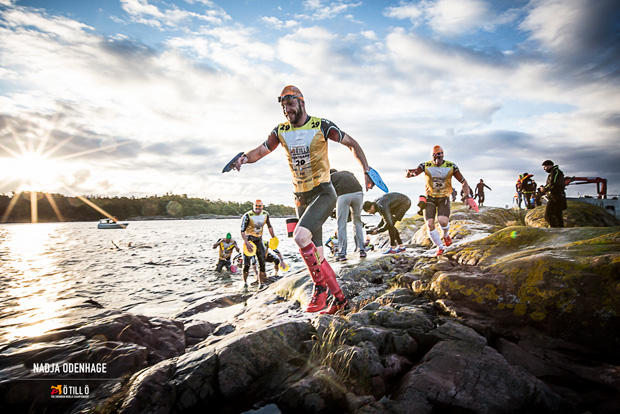
Long time race leaders and former elite swimmers Simon Börjeson and Rasmus Regnstrand prefer to take their shoes off during the swim sections.
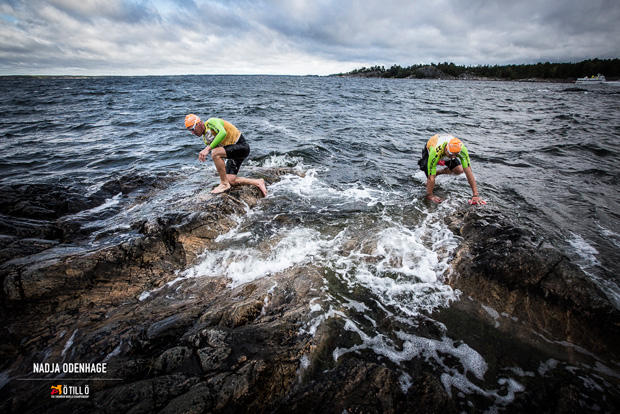
Transitions need to be speedy. Individual setups need to be well planned and practiced in training.

The use of a tether between teammates is common practice. Although it is a fairly straightforward technique on land, in the water the swimmer in back needs to pay attention. It is easy to get your arms wrapped up in the tether.
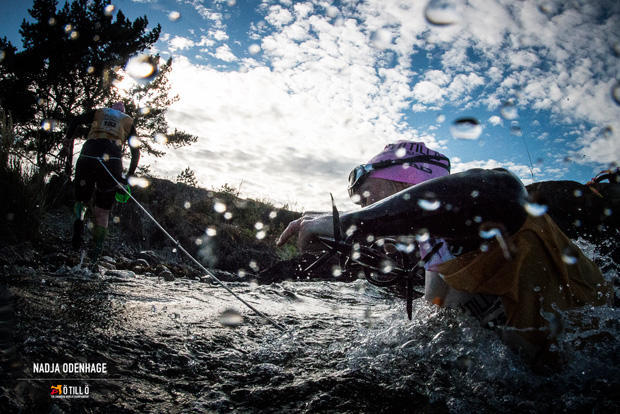
Nearly everybody uses hand paddles. If you have the muscles and the skills to use them, they offer a nice advantage.
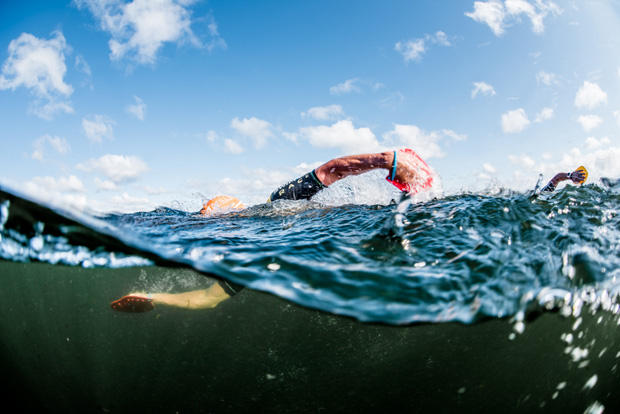
It is hard to find grip on these stones. Trail shoes help, although any shoe used must work on a variety of terrain.
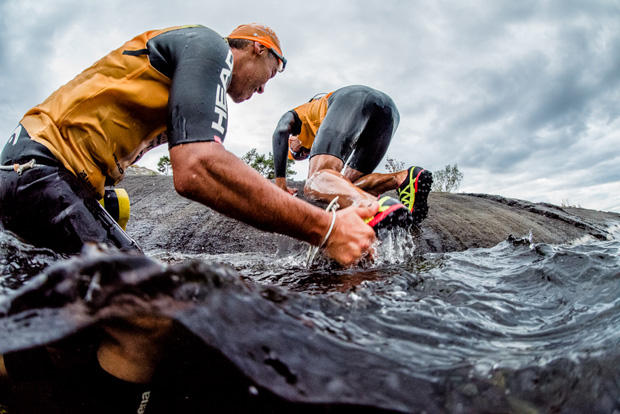
While pull buoys help racers to float, they also need to be tucked away fast while scrambling out of the sea.
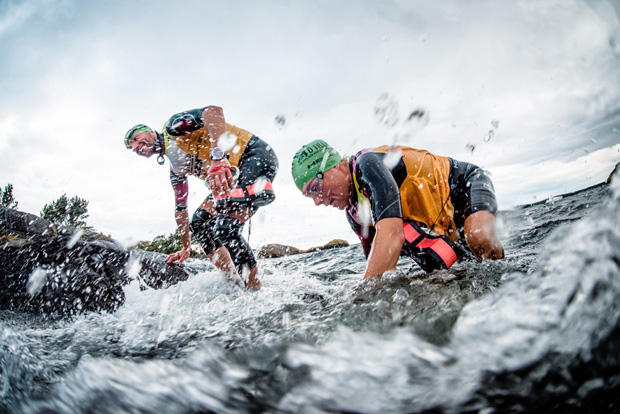
Hand paddles can be had in many shapes and sizes. Most teams write the swim and run distances on the paddles to keep track of where they are on the course.
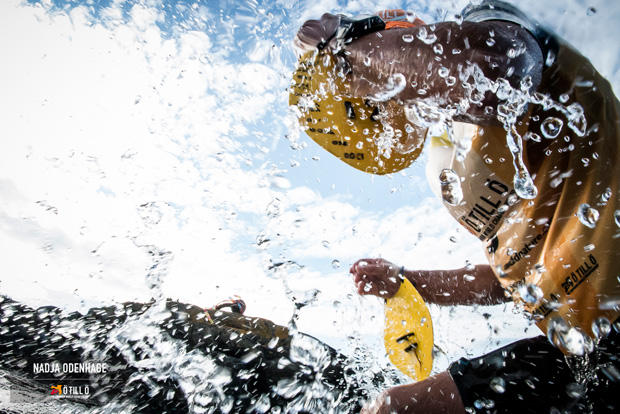
After more than a few SwimRun competitions in the last two years, my teammates and I have a bit of experience between us. There are many diverse approaches to gear and preparation, but no matter what, the crossing of 26 islands needs to be organized.
Pull Buoy
To save the legs for the run portions, most of the competitors use a well know figure-eight shaped piece of foam commonly used in swim workouts – the pull buoy. But there is a wide range of shapes and sizes. Some athletes glue multiple pull buoys together while other SwimRunners use slimmer designs – and many home-grown devices can be seen as well. For instance, a widespread choice is a pull buoy made from empty plastic bottles which are glued together. But all creations should depend on the swimming skills of the user. Racers like myself, who are not huge kickers in the water, tend to use pieces of styrofoam inside compression socks on the shin side. This lets the legs float higher in the water and gives the swimmer an improved position in the rough sea waters. On the other hand, some racers prefer to take their shoes off and stow them in the back of their wetsuits in order to freely kick during the swim sections.
Each competitor recognizes their skills and prepares for the course accordingly. The writer of this article is spoiled to have quality aquanauts among his teammates. That means I don't have to navigate during the swims that range from a length of 100 meter to 1780 meters, but just focus exclusively on the feet of the swimmer in front. A moderate smack on the shoes every 3 to 5 strokes is the sign that everything is going according to plan. Some crews use tethers. We do not as we haven't had trouble sticking together during the swim segments. It is also vital for the front swimmer to repeatedly double-check what's happening in the back.
Paddles
There is also debate over the use of another swim drill device – the hand paddle. Particularly in Sweden, some athletes craft hand paddles themselves. Designs range from enormous pieces of Perspex plastic to smaller standard builds. Usually large paddles are more common, but the use of paddles for long distance swimming doesn't come easy. A lot of training is needed to build up the strength and stamina to efficiently use paddles during such a long distance. While it can be a huge benefit, it can also easily lead to shoulder pains during and after the swim sections. Racers need to keep in mind that this can be a latent problem and should choose their paddle size carefully and use it consistently in training.
Shoes
The title fight across the archipelago requires a pretty special shoe. For myself, I'm not sure if the perfect shoe exists. Oily stones throughout the transitions makes it difficult to get both in and out of the water. The slippery rocks don't offer much hold and continue to be challenging as the racers scramble out of the sea and head inland. The varied topography makes light trail shoes the logical choice for a competition like this. Most of the water leaves the shoes quickly, after just a few steps. For sure your feet will stay wet, but no worse than any average rainy day. We didn't problems with uncomfortably wet shoes, but the diversity of the course is the actual test for the chosen footwear. The long run sections on the partially cemented Ornö-roads are a large part of the course. Selecting a hard trail sole can cause some pain. Consequently, we went with light trail shoes and a soft sole. For us it was the best compromise for dealing with the greasy stones, the climbs, and finally the intolerable partially paved roads on Ornö island. In order to prevent blisters, the key is to use very tight, snug fitting socks!
Wetsuit
The market is slowly adjusting to address the specific needs of SwimRunners. Nevertheless, most racers do still cut down regular triathlon wetsuits to their specifications. Currently there are a few special SwimRun suits available. Usually the suits are more durable in order to deal with the vegetation and sharp stones along the course. Some specialty suit makers offer improved durability combined with a still-flexible upper body, to allow for ease of running as well as swimming. Additional pockets in the front and back offer space for gels, mandatory equipment, and GPS device (to track each team along the course). At this year’s race we started off with our front pockets filled with gels. We were able to replenish our supplies at the aid stations. Currently all SwimRun suits on the market have special pockets to store food and gear.
The most prominent feature of the SwimRun wetsuit is possibly the front zipper. It makes a huge difference on the runs and renders the traditional back zipper unnecessary. In our experience, opening just the front zipper is more than enough to put on the suit. It looks like new SwimRun suits will do away with the back zip. On some running sections, you need to strip the suit off the upper body to cool down, but even this is easy with the front zipper only.
Grinning, struggling, cheering and suffering. Team after team reaches the finish line and the end of an extraordinary day. As the last brave teams of two run in the direction of the finish line in front of the charming Utö Värdshus, other racers gather around the finish area. It's getting cold. People drink beer. There are exhausted but happy faces all around. Swimming 10 kilometers through cold and undulating waters is a test. Running 65 kilometers through rugged terrain requires both mental and physical strength. In addition to teamwork and camaraderie, the equipment makes up a vital part of a race like ÖTILLÖ. Your teammate and your gear be chosen carefully if you want to wake up happy the next morning, captivated and intrigued by such an intense alcohol bet!


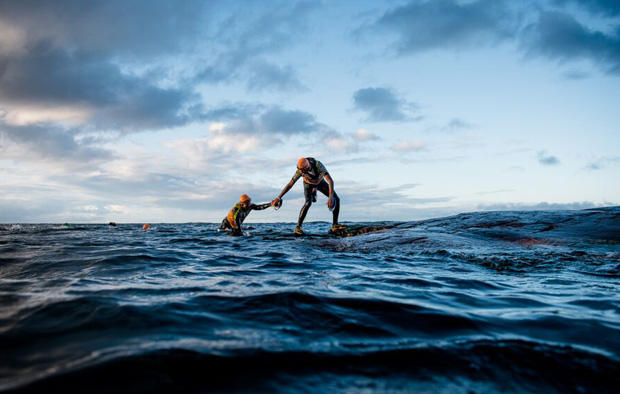
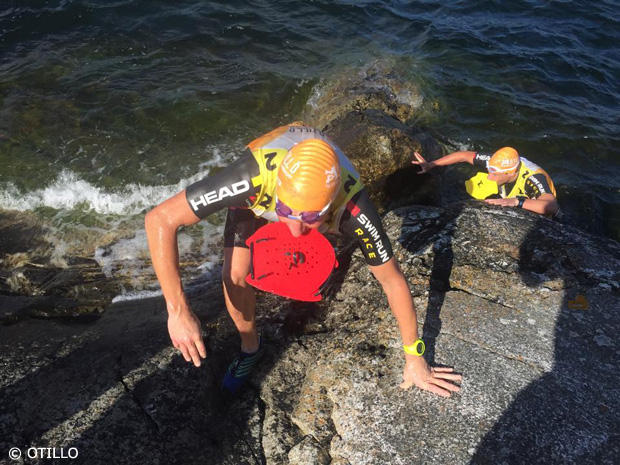
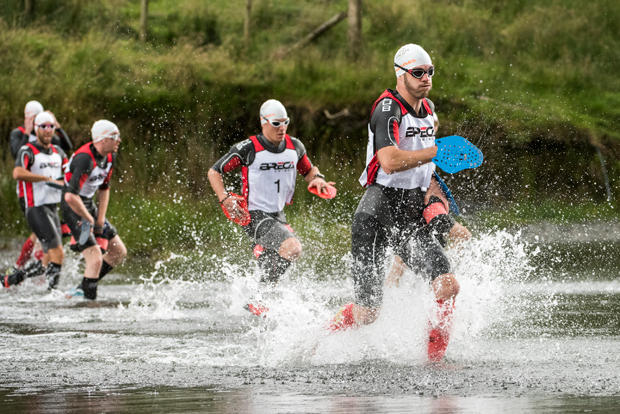
Start the discussion at slowtwitch.northend.network